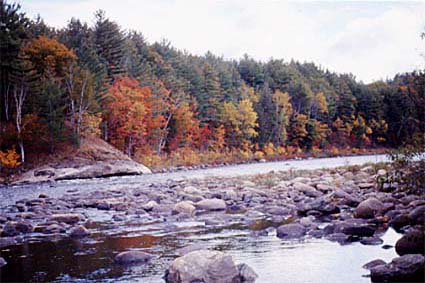|
and choose "Open image in New Window".
The Hudson at New York City
The Hudson at New York City. Manhattan is on the left of the picture.
Location: 43N 74W (New York State, USA); length: 500 kilometres (300 miles); drainage area: 34,000 square kilometres (13,000 square miles). The Hudson is an important river in New York State. Its headwaters are in Lake Tear of the Clouds in the High Peaks region of the Adirondack Mountains, from where it flows almost directly south to the Atlantic Ocean at New York City. 
The Hudson in the Adirondacks.The first European to see the Hudson River was Giovanni da Verrazano in 1524 (and for whom the Narrows linking the Hudson to the Atlantic Ocean are named). However, in 1609 Henry Hudson, working for the Dutch East Indian Company, was the first European to explore the valley route. The company then established settlements both at Albany and at Manhattan. The Hudson Valley became an important routeway to Montreal and the west of the U.S. The Erie Canal was built to link the Hudson and New York City with the Great Lakes. Although it is close to some of the most built-up regions of America, the Hudson valley remains largely unspoiled, with few industrial sites except within New York City. In part this has been due to historical reasons. The Middle Hudson Valley was owned by some of the most powerful and wealthy colonists, and although the river was used for commerce as far upstream as Albany, the Middle Hudson remained firmly in the hands of a few wealthy families (many of whom were signatories to the U.S. constitution) and who had little interest in developing their land for industry.
Hudson River estates
The oldest, smallest, and most historic is Clermont, the home of seven generations of the Livingstone family. They lived there continuously from 1730 to 1962. Chancellor Robert R Livingstone was the most famous and responsible for the Louisiana Purchase and for the invention of the first American steamboat, which plied the Hudson outside his estate. Other mansions include the Mills mansion built on land acquired in 1792 by New York's 3rd governor (whose wife was a member of the Livingstone family). It became home to financier Ogden Mills (who also married a Livingstone). The homes of Franklin D Roosevelt, Montgomery Place, The Vanderbuilt mansion and Olana (the home of leading Hudson River School artist Frederic Church) and Wilderstein, a Queen Anne mansion, make up the other famous mid-Hudson historic mansions. |